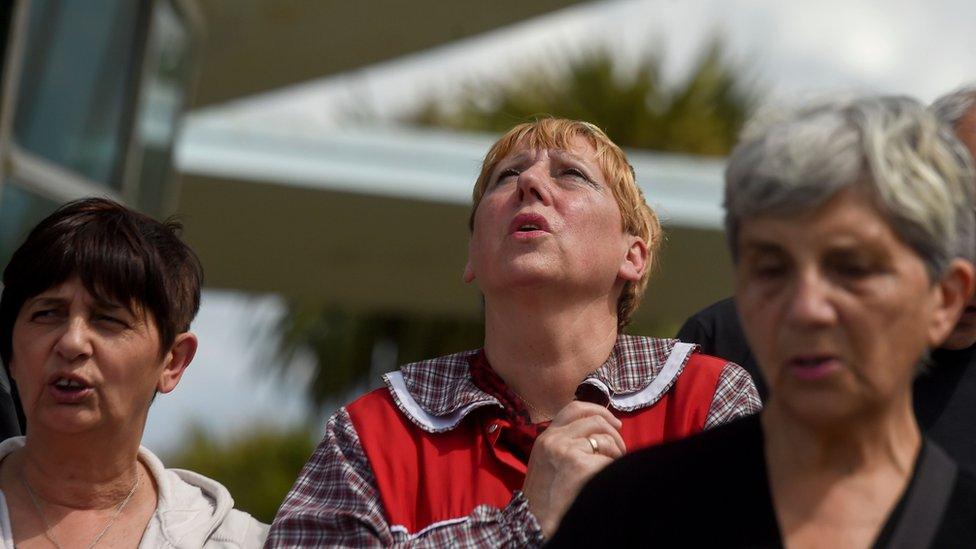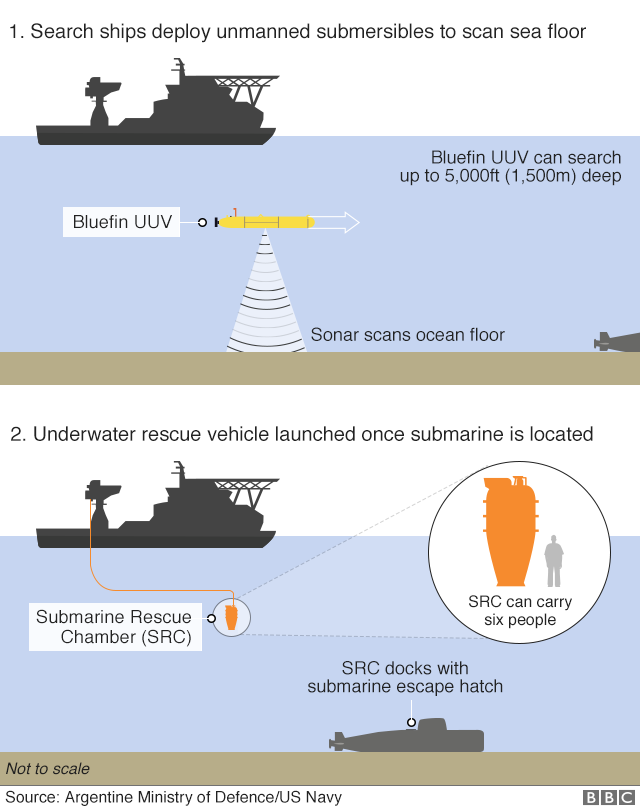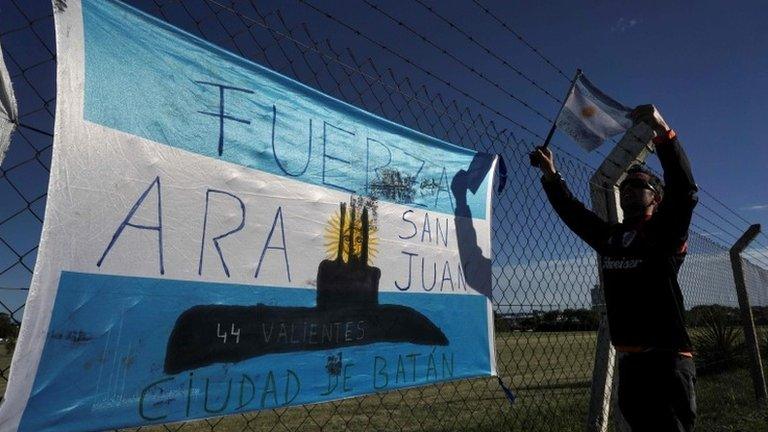Argentina missing submarine: Loud noise investigated
- Published

People prayed outside an Argentine navy base as fears grew about the missing sub's oxygen supply
Argentina's navy is investigating reports of a loud noise detected a few hours after a submarine went missing.
The ARA San Juan disappeared last Wednesday with 44 people on board.
A spokesman called the noise a "hydro-acoustic anomaly" and would not confirm whether there had been an explosion.
Captain Enrique Balbi said the situation was getting critical and "concern is growing more and more" amid fears oxygen on board is close to running out.
One crew member's sister said: "I feel like I'm waiting for a corpse."
Elena Alfaro, who was waiting alongside other family members at the Mar del Plata naval base, told TN news network: "I feel like I'm at a wake. I also feel time passing and time is crucial."

Elena Alfaro's brother Cristian Ibañez is on board
More than a dozen countries including Russia and the US have sent resources to take part in the search for the submarine.
On Thursday, a US Navy aircraft detected an "object" near the submarine's last known location, the news agency Reuters reported, but the US Navy quickly confirmed that it was not from the missing sub.
On Wednesday, Mr Balbi told journalists: "Today is the seventh day, which was critical for oxygen capacity."
The loud noise happened four or five hours after the submarine's last radio contact, about 30 nautical miles (60 kilometres) north of its last-known position.
"It's a noise," Mr Balbi said. "We don't want to speculate."
Brazil, Chile, Colombia, France, Germany, Peru, South Africa, Uruguay and the UK are among the countries that have sent either ships or planes to help with the search.
The US navy has deployed two underwater vehicles which use sonar to create images of the sea floor.
A Nasa research aircraft has also flown over the search area but failed to spot anything.
What happened to the sub?
The ARA San Juan was returning from a routine mission to Ushuaia, near the southern-most tip of South America, when it reported an "electrical breakdown".

According to naval commander Gabriel Galeazzi, the submarine surfaced and reported the breakdown, which Capt Galeazzi described as a "short circuit" in the sub's batteries.
The sub was ordered to cut its mission short and return to the naval base in Mar del Plata immediately.
According to Mr Balbi, the captain of the ARA San Juan contacted the naval base once more after reporting the problem.
In the message, he reportedly said that the problem had been adequately fixed and that the sub would submerge and proceed towards Mar del Plata naval base.
The last contact was made at 07:30 local time (10:30 GMT) on Wednesday 15 November. It is not known what happened to the sub after that contact.
How was the alarm raised?
Argentine navy protocol stipulates that in peace time, submarines make contact twice a day with the base.
When the submarine failed to call in, the Argentine navy began its search for the vessel.
Navy commander Carlos Zavalla at that point spoke only of a "failure to communicate" and urged relatives of the crew to remain calm.
There was no mention by navy officials of the vessel having any problems at the time and rumours of a fire on board were dismissed by Mr Balbi.
When did news of the breakdown emerge?
On Sunday, relatives of some of the crew said that they had been told in messages sent before contact with the submarine was lost, that there was a problem with the sub's batteries.

Naval commander Gabriel Galeazzi told journalists about the mechanical problems on Monday
On Monday, Capt Galeazzi confirmed the sub's captain had reported the issue on Wednesday.
Capt Galeazzi said that mechanical problems were not uncommon and rarely posed a risk. "A warship has a lot of backup systems, to allow it to move from one to another when there is a breakdown," he said.
He also said that the sub had not sent a distress signal to the navy base.
Who is on board?
There are 44 crew on board the submarine, which is under the command of Pedro Martín Fernández.
Forty-three of the crew are men but there is also one woman, Eliana María Krawczyk. The 35-year-old is the first female officer in Argentina to serve on a submarine.

Her family says it was Eliana María Krawczyk's dream to become a submariner
Nicknamed "the queen of the sea" by her father she comes from Oberá, a city in northern Argentina.
Despite having been born and raised far inland, her relatives say that "she was born to be a submariner", citing her "will of steel" and a passion for her job.
The rest of the crew is made up of submariners of varying ages and experience.
The sub's engineer, Hernán Rodríguez, has been on the ARA San Juan for 11 years, local media reported.
How the missing submarine could be located

- Published21 November 2017

- Published22 November 2017

- Published23 November 2017
